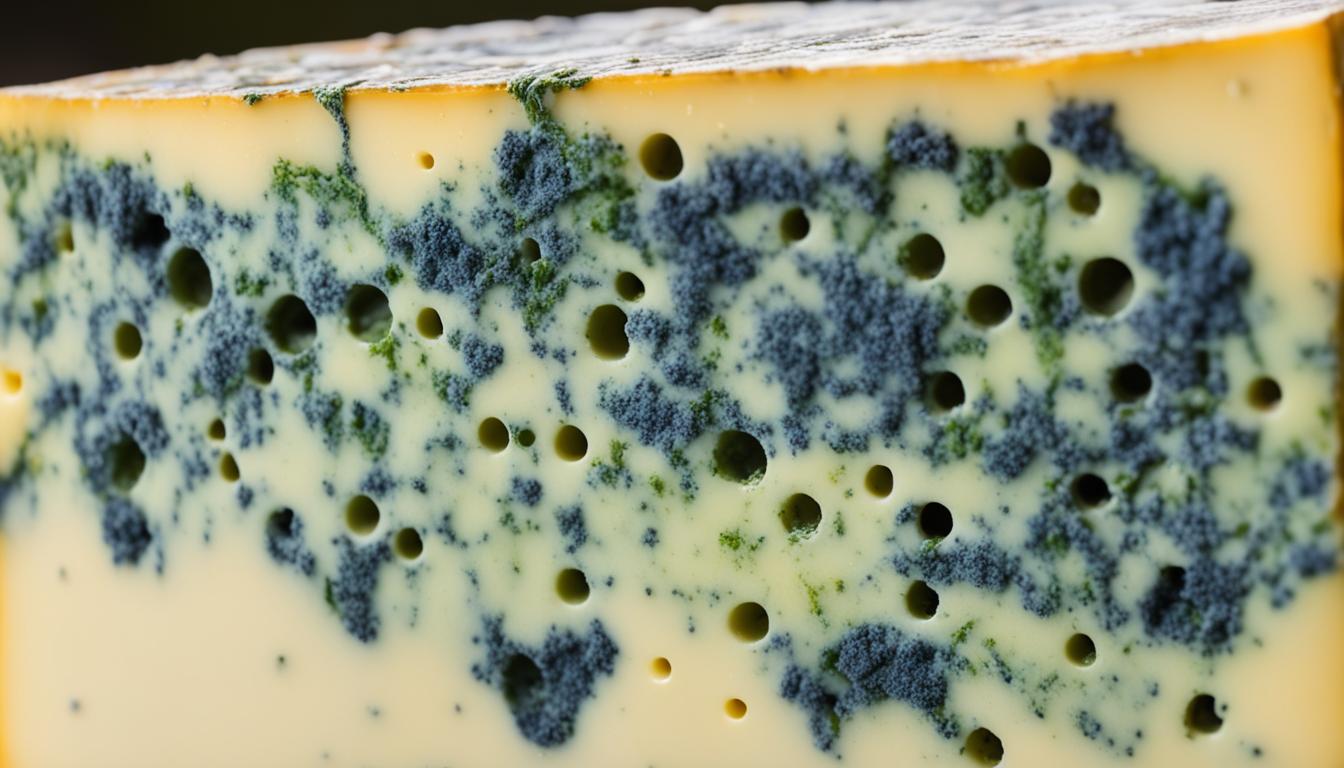
Everything You Should Know About cheese with Mold
In the world of cheese, mold adds a unique and intriguing dimension to certain varieties. Mold-ripened cheeses offer a wide range of flavors, textures, and aromas that are worth exploring. From the tangy blue veins of Roquefort to the velvety rind of a camembert, cheese with mold is a culinary delight that should not be missed.
This article will take you on a journey through the fascinating world of mold-ripened cheeses. We will delve into the different varieties available, discuss their surprising health benefits, and provide you with tips on how to enjoy them safely. So, are you ready to embark on this cheesy adventure?
Key Takeaways:
- ● Cheese with mold offers a unique flavor profile and adds depth to your culinary experiences.
- ● Mold-ripened cheeses come in various varieties, such as blue cheese and camembert, each with distinct characteristics.
- ● These cheeses have nutritional value and may have probiotic properties, benefiting your overall health.
- ● Enjoying mold-ripened cheeses safely involves choosing reputable producers, proper storage, and handling.
- ● Explore the world of cheese with mold to savor its exquisite flavors and reap its potential health benefits.
Exploring Varieties of Mold-Ripened Cheeses
When it comes to mold-ripened cheeses, there is a wide array of indulgent flavors and textures to discover. From the tangy blue cheese to the creamy camembert, each variety brings its own unique characteristics to the table. Let’s explore some of the most popular options:
1. Blue Cheese
Known for its distinctive blue veins, blue cheese offers a bold and pungent flavor profile. This cheese develops its signature mold from the Penicillium cultures infused during the aging process. The result is a rich and earthy cheese that pairs beautifully with crackers or in salads.
2. Brie
Brie is a soft, bloomy rind cheese that boasts a creamy texture and a delicate taste. The mold on the rind of Brie cheese helps break down the cheese’s proteins, resulting in a luscious and buttery underlayer. Enjoy it with fruit preserves and a crusty baguette for a gourmet experience.
3. Camembert
Similar to Brie, Camembert is another velvety-soft cheese with a white mold rind. It has a slightly more robust flavor, making it a favorite among cheese connoisseurs. Spread it on warm bread or serve it alongside cured meats for a decadent appetizer.
4. Roquefort
Roquefort, a famous blue cheese from France, has a rich and crumbly texture with intense flavors. The cheese is injected with Penicillium roqueforti spores, which develop the characteristic blue-green marbling. Pair this cheese with honey and walnuts for a delightful combination of sweet and savory.
5. Cambozola
A combination of camembert and gorgonzola, Cambozola is a creamy and luxurious cheese that delivers the best of both worlds. With its mild blue veins and velvety texture, Cambozola offers a delicate balance of flavors. Enjoy it on its own or crumble it over salads or pasta dishes.

With these enticing options, mold-ripened cheeses open up a world of flavors and experiences. Whether you prefer the boldness of blue cheese or the subtlety of brie, there’s a mold-ripened cheese waiting to tantalize your taste buds.
Health Benefits of Cheese with Mold
When it comes to cheese, most people are familiar with classics like cheddar, mozzarella, and Swiss. However, there is a whole world of cheese with mold varieties waiting to be discovered. Not only do these cheeses offer unique flavors and textures, but they also provide surprising health benefits.
Mold-ripened cheeses, such as blue cheese, camembert, and brie, are often associated with a distinct aroma and tangy taste. However, they also pack a powerful nutritional punch. Here are some of the health benefits you can enjoy when consuming cheese with mold:
- Rich in Nutrients: Cheese with mold is a good source of essential nutrients such as protein, calcium, vitamin B12, and phosphorus. These nutrients are vital for maintaining strong bones, supporting brain function, and promoting overall well-being.
- Potential Probiotic Properties: Mold-ripened cheeses may contain certain strains of beneficial bacteria known as probiotics. These probiotics can help improve gut health, boost the immune system, and enhance digestion.
- Aids in Vitamin K Intake: Mold-ripened cheeses are also a good source of vitamin K, a nutrient that plays a crucial role in blood clotting and bone health.
- Possible Antioxidant Effects: Some studies suggest that certain compounds found in cheese with mold, such as phenolic compounds, may have antioxidant properties. Antioxidants help protect our cells from damage caused by harmful free radicals.
It’s important to note that while cheese with mold offers these potential health benefits, moderation is key. Too much cheese consumption can contribute to high saturated fat and sodium intake, which may increase the risk of certain health conditions. As always, it’s best to enjoy cheese with mold as part of a balanced diet.
So, the next time you reach for your favorite cheese with mold, savor the enticing flavors and enticing aromas while also reaping the many health benefits it has to offer.

The Incredible Journey of Cheese with Mold
Before we dive into the specifics of the health benefits, let’s take a moment to appreciate the fascinating journey that cheese with mold undergoes. From the careful addition of specific molds to the precise aging process, every step contributes to the creation of these unique and flavorful cheeses.
“The creation of mold-ripened cheeses involves a delicate balance of art and science. It starts with the careful inoculation of cheese with specific mold cultures, which gradually transform the texture, taste, and aroma of the cheese. The aging process allows the mold to develop and thrive, creating the distinct characteristics that make these cheeses so beloved.”
Now that we have a better understanding of the journey that cheese with mold takes, let’s explore the diverse varieties and flavors that await cheese enthusiasts like you.
| Cheese with Mold Variety | Origin | Flavor Profile |
|---|---|---|
| Blue Cheese | England | Sharp, tangy, with pockets of blue mold |
| Camembert | France | Soft, creamy, with a delicate white mold rind |
| Gorgonzola | Italy | Rich, tangy, with blue-green veins of mold |
Tips for Enjoying Mold-Ripened Cheeses Safely
When it comes to indulging in the delightful world of mold-ripened cheeses, there are a few important tips to keep in mind for a safe and enjoyable experience. Whether you’re a seasoned cheese lover or just beginning your gastronomic journey, these guidelines will ensure that you savor these delectable cheeses with confidence.
1. Choose Reputable Producers
Opt for established and reputable cheese producers known for their high-quality standards. Look for certifications and awards that highlight their commitment to safety and excellence. This way, you can trust that the cheese you’re enjoying has been produced under controlled conditions.
2. Store and Handle with Care
Mold-ripened cheeses require specific storage and handling to maintain their flavor and quality. Keep them refrigerated at the appropriate temperature, usually between 35-45°F (1-7°C), in airtight containers to prevent cross-contamination. Additionally, store them away from other foods with strong odors to avoid flavor absorption.
3. Observe the Cheese’s Appearance
Before consuming mold-ripened cheeses, visually inspect them for any signs of excessive mold growth or unpleasant odors. While mold is an essential part of the aging process, excessive mold growth or unusual discoloration may indicate spoilage. Trust your senses and refrain from consuming cheese that appears visually compromised.
“Savor the unique flavors and textures of mold-ripened cheeses, but always prioritize your safety and well-being.”
4. Experiment with Pairings
Expand your cheese tasting experience by pairing mold-ripened cheeses with complementary flavors. From crusty bread and fresh fruits to honey and nuts, there are endless possibilities that enhance the taste profiles of these cheeses. Get creative and explore different combinations to discover your favorite pairings.
5. Serve at the Right Temperature
The temperature at which you serve mold-ripened cheeses can greatly influence their taste and texture. Soft and creamy varieties, like brie and camembert, are best enjoyed at room temperature, allowing their flavors to fully develop. On the other hand, firmer blue cheeses benefit from a slightly cooler serving temperature to enhance their tanginess.
6. Enjoy with Confidence
Finally, remember that mold-ripened cheeses have a rich history and are enjoyed by cheese connoisseurs worldwide. By following these tips, you can confidently embrace the unique characteristics and flavors that these cheeses offer. So go ahead, indulge in this culinary delight with the assurance that you’re experiencing mold-ripened cheeses safely and responsibly.
Conclusion
In conclusion, cheese with mold offers a captivating journey for your taste buds. From the rich and tangy flavors of blue cheese to the creamy and earthy profiles of camembert, mold-ripened cheeses present a diverse array of taste experiences.
But it’s not just about the flavors. These cheeses also come with an array of health benefits. With their high nutritional value and potential probiotic properties, mold-ripened cheeses can contribute to a well-balanced diet and promote digestive health.
To fully enjoy the unique experience of mold-ripened cheeses, it’s crucial to prioritize safety. Choose reputable producers, ensure proper storage and handling, and follow the recommended guidelines for safely consuming these delectable cheeses.
If you need expert assistance with mold assessments, prevention, or remediation, look no further than Fix Mold Miami. With their years of experience and commitment to excellence, they can help ensure a safe and mold-free environment. Contact Fix Mold Miami today at 305-465-6653.




